Impreza
WRX
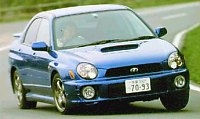 Strangely,
the first generation WRX was not a brilliant design in first sight, but
the more you looked the more beautiful it grew on you. So after 8 years
of falling in love with it, it’s hard to accept a successor so ugly.
Ugly
! pardon me, I rarely use such a subjective description but I can’t
help
feeling sad about its styling. No matter how many times I saw it, its
strangely
undynamical rectangular shape, odd big circular headlights and
complicated
face still conflicts with our inherent sense of beauty. Strangely,
the first generation WRX was not a brilliant design in first sight, but
the more you looked the more beautiful it grew on you. So after 8 years
of falling in love with it, it’s hard to accept a successor so ugly.
Ugly
! pardon me, I rarely use such a subjective description but I can’t
help
feeling sad about its styling. No matter how many times I saw it, its
strangely
undynamical rectangular shape, odd big circular headlights and
complicated
face still conflicts with our inherent sense of beauty.
OK,
we don’t judge cars purely on styling, especially for this kind of
A-to-B
driver’s cars. Let’s see the chassis - 2.5 times as rigid in torsion as
the outgoing car guarantees superior handling, ride and of course,
should
pass the strictest safety regulations. This is what the project manager
most proud of. The next thing is improved interior space while
preserving
a short wheelbase, which grew just 5mm, thus guarantees nimble
handling.
I’m not too convinced about this one, considering the new WRX has got
much
longer front and rear overhangs, hence an extra 55 mm of overall
length.
Worse of all, the bigger and stronger chassis accompany with all other
enhancement adds 100 kg to the car, despite of aluminium bonnet. (note:
various figures were quoted by different sources because they compare
the
new WRX with different "old car", say, American sources compared with
2.5RS,
UK sources compared with Impreza Turbo. However, according to Japanese
official figures the new WRX weighs 1340 kg, versus the 1240 kg of the
previous non-STi WRX Version VI)
The
suspension is still all struts set up, which has been proved successful
by various WRC teams. Yes, in the world of rallying MacPherson strut is
more favourable than the mighty double wishbones because it provides
better
camber control for long-travel suspensions. In the new WRX, the struts
are attached to the strengthened body with new front sub-frame and
revised
geometry. Front suspension lateral links are made of aluminium
(excluding
US version). The roll center has been raised by 33mm though I have no
idea
what this suggest. (we do not say roll center the higher the better or
the lower the better)
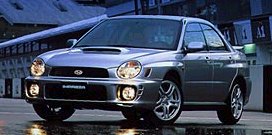 Tracks
have been widened as the body is 30mm wider, this should help cornering
stability. Wheels are still 16-inch wearing 205 width tyres but there
is
optional 215/45ZR17 which is also standard in UK’s version. Brakes are
no pizza size, with diameter just 294mm front and 266mm rear, thus it’s
still a relatively weak link of WRX. It seems that Subaru has reserved
the best brakes for STi version. Tracks
have been widened as the body is 30mm wider, this should help cornering
stability. Wheels are still 16-inch wearing 205 width tyres but there
is
optional 215/45ZR17 which is also standard in UK’s version. Brakes are
no pizza size, with diameter just 294mm front and 266mm rear, thus it’s
still a relatively weak link of WRX. It seems that Subaru has reserved
the best brakes for STi version.
What
matter most to WRX enthusiasts, however, is the fire-breathing power
plant,
which gains least improvement or perhaps even a bit deterioration due
to
stricter emission laws. The basic engine is still that 1994 c.c. boxer
4-cylinder, code name EJ20, still all-alloy design, still having 4
camshafts,
16 valves and a single IHI turbocharger mating air-to-air intercooler.
What’s new? Subaru will tell you it’s 80% new, but more specific wise
there
are only AVCS variable valve timing at the intake side and a 11% larger
intercooler. Thanks to the variable valve timing, Subaru claims the
torque
curve is much more flatter, with 80% of torque available from 2200rpm.
Remarkable? I don’t think so. There are some European turbo engines can
deliver 90% torque at 2000 rpm. Even the high-boost Audi RS4 can reach
peak torque at just 2500 rpm !
Peak
power and torque are 250 hp and 246 lbft (both JIS), compare with the
last
280 hp Japanese WRX Version VI (still non-STi, remember), there is a
deficit
of 30 horsepower and a weight penalty of 100 kg ! Blame to the new
emission
regulations which requires 3 catalytic converters including a
close-coupled
cat near the exhaust collector (to deal with cold start emission, see
Technical
School). No matter how flatter the torque curve is, undoubtedly the new
WRX will be much slower than its predecessor in acceleration.
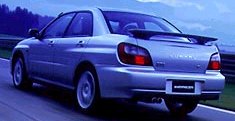 The
above applies to Japanese version only. For the first time, UK and US
are
offered with WRX officially and their output are even lower. UK’s car
(which
is identical to Australia’s) has 218 hp / 215 lbft while US version has
227 hp / 217 lbft. Most journalists, such as Car And Driver and
Autocar,
blamed that to stricter emission requirement but few of them noticed
the
export engines do not have AVCS while the turbine is also smaller in
diameter.
The latter means the Japanese pumps out a maximum boost of 17psi
instead
of the export versions' 14.2psi. When deciding to drop these good
things,
cost may be the biggest concern. But someone also believe the Japanese
prefer to keep the best thing exclusively for themselves ! Lastly, the
UK and US versions also differ from the Japanese car by a 8.0:1
compression
ratio versus 9.0:1, which is probably because of emission reasons. The
above applies to Japanese version only. For the first time, UK and US
are
offered with WRX officially and their output are even lower. UK’s car
(which
is identical to Australia’s) has 218 hp / 215 lbft while US version has
227 hp / 217 lbft. Most journalists, such as Car And Driver and
Autocar,
blamed that to stricter emission requirement but few of them noticed
the
export engines do not have AVCS while the turbine is also smaller in
diameter.
The latter means the Japanese pumps out a maximum boost of 17psi
instead
of the export versions' 14.2psi. When deciding to drop these good
things,
cost may be the biggest concern. But someone also believe the Japanese
prefer to keep the best thing exclusively for themselves ! Lastly, the
UK and US versions also differ from the Japanese car by a 8.0:1
compression
ratio versus 9.0:1, which is probably because of emission reasons.
The
engine still drives through a 5-speed manual to all 4 wheels via 3
differentials,
among which the center differential is viscous-coupling LSD while the
rear
is Suretrac (torque biasing) mechanical LSD by AP. Center LSD normally
distribute 50/50 torque to front and rear. In case of wheelspin, it
will
send more torque automatically (rather brainlessly as well) to the
opposite
axle which has more grip. Need front LSD ? go for the STi version
later.
In short, the transmission system remains nearly unaltered from the old
WRX.
On
the Road
Now
let’s see how well our technical analysis match the real world
experience.
Start
the engine, you’ll hear the typical boxer noise. Turbine smooth,
rev-happy
and red-lined at 7,000 rpm seems everything a world-class engine
possess,
but it lacks one important thing - real power. No matter how it rev and
scream, the car does not accelerate like a fireball - a term that used
to describe the old WRX. Even compare with the UK-only old Impreza
Turbo
(215hp), the new UK version WRX (218hp) takes 0.4 more seconds to
finish
0-60mph. That’s 5.7 seconds (250 hp version claimed as 5.3 sec), not
bad,
but deterioration is hardly acceptable.
Subjectively,
it feels even slower. On the one hand, the so-called improved torque
curve
can be hardly detectable. On the contrary, the extra 100kg burden even
made it worse. Off-boast, throttle response is disappointingly
sluggish.
Below 3,000 rpm, power delivery is weak and turbo lag is noticeable.
However,
it revs into live since 3200 rpm where full boast is obtained, then the
torque increase linearly and eagerly towards the 7,000 rpm red-line. No
matter low or mid-range, however, Audi S3 feels decisively more
powerful,
flexible and responsive. In reality, S3 also produces stronger
mid-range
acceleration, in-gear acceleration as well as 0-100 mph. Both cars have
more or less the same power rating and kerb weight, so the differences
lies on the way they deliver their power.
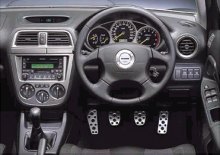 On
the other hand, the improved sound-deadening and vibration-free chassis
makes the car feel even slower subjectively. On
the other hand, the improved sound-deadening and vibration-free chassis
makes the car feel even slower subjectively.
In
contrast, handling is benefited by the rigid chassis. The whole
structure
feels stiffer and more secure. It does not twist or bend like the old
car
on poor surfaces. As a result, the suspension has been set up to
provide
compliant ride million miles ahead of the old car which was never
praised
of ride comfort. This is a road-going rally car you will love to go
shopping
with.
Is
there any improvement in body control or grip? hard to tell, but it is
sure that now the car steers more neutrally and display safe understeer
much later. There’s almost no understeer unless reaching its limit.
Throttle
steer? no problem. The steering feels a bit too light and not sharp
enough
in initial feel, but drive it longer and you’ll discover it actually
provides
good communication and accuracy. And there is no kick-back or vibration
from steering column which characterised both the old WRX or Lancer
Evo.
Gearshift
now has less resistance and still a short and snappy throw. Brakes are
effective but pedal feel is too light to inspire confidence.
Compare
with Audi S3 again, the WRX wins decisively in handling. It has better
controlled ride over poor surfaces, better high speed body control,
more
steering feedback and more fluent control overall.
In
the end, the WRX is still the ultimate driver’s car in its class.
There’s
nothing can compare with it once in a twisty road. Performance is its
biggest
weakness, so is look and packaging. In my opinion, STi or Evo 7 are
much
better bet and worth the extra money.
|
 With
hot versions like WRX and STi, I bet few of you are actually interested
in reading this article. Anyway, it’s my policy to describe every car
no
matter interesting or boring. So let us have a brief view into the
regular
Impreza first.
With
hot versions like WRX and STi, I bet few of you are actually interested
in reading this article. Anyway, it’s my policy to describe every car
no
matter interesting or boring. So let us have a brief view into the
regular
Impreza first.
 Strangely,
the first generation WRX was not a brilliant design in first sight, but
the more you looked the more beautiful it grew on you. So after 8 years
of falling in love with it, it’s hard to accept a successor so ugly.
Ugly
! pardon me, I rarely use such a subjective description but I can’t
help
feeling sad about its styling. No matter how many times I saw it, its
strangely
undynamical rectangular shape, odd big circular headlights and
complicated
face still conflicts with our inherent sense of beauty.
Strangely,
the first generation WRX was not a brilliant design in first sight, but
the more you looked the more beautiful it grew on you. So after 8 years
of falling in love with it, it’s hard to accept a successor so ugly.
Ugly
! pardon me, I rarely use such a subjective description but I can’t
help
feeling sad about its styling. No matter how many times I saw it, its
strangely
undynamical rectangular shape, odd big circular headlights and
complicated
face still conflicts with our inherent sense of beauty.
 Tracks
have been widened as the body is 30mm wider, this should help cornering
stability. Wheels are still 16-inch wearing 205 width tyres but there
is
optional 215/45ZR17 which is also standard in UK’s version. Brakes are
no pizza size, with diameter just 294mm front and 266mm rear, thus it’s
still a relatively weak link of WRX. It seems that Subaru has reserved
the best brakes for STi version.
Tracks
have been widened as the body is 30mm wider, this should help cornering
stability. Wheels are still 16-inch wearing 205 width tyres but there
is
optional 215/45ZR17 which is also standard in UK’s version. Brakes are
no pizza size, with diameter just 294mm front and 266mm rear, thus it’s
still a relatively weak link of WRX. It seems that Subaru has reserved
the best brakes for STi version.  The
above applies to Japanese version only. For the first time, UK and US
are
offered with WRX officially and their output are even lower. UK’s car
(which
is identical to Australia’s) has 218 hp / 215 lbft while US version has
227 hp / 217 lbft. Most journalists, such as Car And Driver and
Autocar,
blamed that to stricter emission requirement but few of them noticed
the
export engines do not have AVCS while the turbine is also smaller in
diameter.
The latter means the Japanese pumps out a maximum boost of 17psi
instead
of the export versions' 14.2psi. When deciding to drop these good
things,
cost may be the biggest concern. But someone also believe the Japanese
prefer to keep the best thing exclusively for themselves ! Lastly, the
UK and US versions also differ from the Japanese car by a 8.0:1
compression
ratio versus 9.0:1, which is probably because of emission reasons.
The
above applies to Japanese version only. For the first time, UK and US
are
offered with WRX officially and their output are even lower. UK’s car
(which
is identical to Australia’s) has 218 hp / 215 lbft while US version has
227 hp / 217 lbft. Most journalists, such as Car And Driver and
Autocar,
blamed that to stricter emission requirement but few of them noticed
the
export engines do not have AVCS while the turbine is also smaller in
diameter.
The latter means the Japanese pumps out a maximum boost of 17psi
instead
of the export versions' 14.2psi. When deciding to drop these good
things,
cost may be the biggest concern. But someone also believe the Japanese
prefer to keep the best thing exclusively for themselves ! Lastly, the
UK and US versions also differ from the Japanese car by a 8.0:1
compression
ratio versus 9.0:1, which is probably because of emission reasons.
 On
the other hand, the improved sound-deadening and vibration-free chassis
makes the car feel even slower subjectively.
On
the other hand, the improved sound-deadening and vibration-free chassis
makes the car feel even slower subjectively.
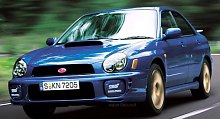 As
before, the hottest WRX is the STi version. If you have never heard the
name, let me explain again: STi standards for Subaru Technica
International.
Many people say it is equivalent to BMW’s M-division but I think it is
better to be compared to AMG or HSV. In many ways it operates like an
in-house
tuner, concentrating in modifying cars in a human-intensive technique
and
supplying racing parts to tuning market. About one-forth of all WRX
produced
will be the STi version.
As
before, the hottest WRX is the STi version. If you have never heard the
name, let me explain again: STi standards for Subaru Technica
International.
Many people say it is equivalent to BMW’s M-division but I think it is
better to be compared to AMG or HSV. In many ways it operates like an
in-house
tuner, concentrating in modifying cars in a human-intensive technique
and
supplying racing parts to tuning market. About one-forth of all WRX
produced
will be the STi version.
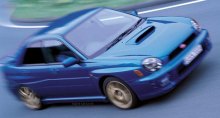 Unlike
the standard WRX, you’ll feel the STi has real power. Turbo lag is
lighter
(but still too much compare with Audi or Porsche), throttle response is
sharper, more punch is available all the time. But compare with the
standard
car means nothing. Take an old STi Version IV, V or VI, you’ll feel the
extra punch fails to deliver the same kind of performance in straight
line
because it carries an extra 155 kg. Subaru knows that, so it gave STi
the
company’s first 6-speed manual to quicken acceleration. It’s a good
transmission,
with metallic feel and ideally-spaced ratios, but I doubt if it can do
0-60 in 4.6 seconds like its predecessor.
Unlike
the standard WRX, you’ll feel the STi has real power. Turbo lag is
lighter
(but still too much compare with Audi or Porsche), throttle response is
sharper, more punch is available all the time. But compare with the
standard
car means nothing. Take an old STi Version IV, V or VI, you’ll feel the
extra punch fails to deliver the same kind of performance in straight
line
because it carries an extra 155 kg. Subaru knows that, so it gave STi
the
company’s first 6-speed manual to quicken acceleration. It’s a good
transmission,
with metallic feel and ideally-spaced ratios, but I doubt if it can do
0-60 in 4.6 seconds like its predecessor. 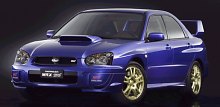 Poor
sales proves that people hated the design of the bug-eye
second-generation
Impreza. Therefore after just less than 2 years, Subaru made an early
facelift
to the Impreza. The restyle was penned by Prodrive design chief Peter
Steven.
It has a much revised front end, from a pair of smaller headlights to
reshaped
bonnet and bumpers. It certainly improves visual appeal.
Poor
sales proves that people hated the design of the bug-eye
second-generation
Impreza. Therefore after just less than 2 years, Subaru made an early
facelift
to the Impreza. The restyle was penned by Prodrive design chief Peter
Steven.
It has a much revised front end, from a pair of smaller headlights to
reshaped
bonnet and bumpers. It certainly improves visual appeal.
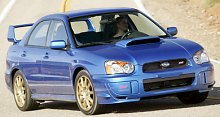 American
car lovers used to be treated as "second-class citizens" by Japanese
car
makers. They are usually offered with less powerful cars compare with
Japanese
or European markets. Now Subaru is going to change this by introducing
a 300-horsepower Impreza WRX STi to the US market. This car has more
power
than its Japanese and European sisters, which should make the latter
jealous.
American
car lovers used to be treated as "second-class citizens" by Japanese
car
makers. They are usually offered with less powerful cars compare with
Japanese
or European markets. Now Subaru is going to change this by introducing
a 300-horsepower Impreza WRX STi to the US market. This car has more
power
than its Japanese and European sisters, which should make the latter
jealous.
 With
only 2 model lines, Saab is a very small company. In an increasingly
competitive
market it can no longer survive like this. Even the new 9-3 is pretty
good,
its sales is as disappointing as Jaguar X-Type. On the other hand, the
9-5 is outdated now. The company has been losing money since GM took
full
control in 2000. This year, GM finally ran out of patience and decided
to take drastic actions to stop Saab bleeding. They want to add a third
model line to increase sales, but at the same time without investment a
lot of money into development. They thought of a "clever" solution -
asked
Saab to restyle a Japanese-built Subaru Impreza Wagon, add a Saab-style
grille and blackened D-pillars, smoothen the bumpers and bonnet scoop
and
rebadge it as Saab 9-2X.
With
only 2 model lines, Saab is a very small company. In an increasingly
competitive
market it can no longer survive like this. Even the new 9-3 is pretty
good,
its sales is as disappointing as Jaguar X-Type. On the other hand, the
9-5 is outdated now. The company has been losing money since GM took
full
control in 2000. This year, GM finally ran out of patience and decided
to take drastic actions to stop Saab bleeding. They want to add a third
model line to increase sales, but at the same time without investment a
lot of money into development. They thought of a "clever" solution -
asked
Saab to restyle a Japanese-built Subaru Impreza Wagon, add a Saab-style
grille and blackened D-pillars, smoothen the bumpers and bonnet scoop
and
rebadge it as Saab 9-2X.
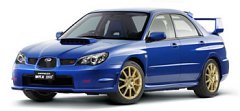 Just
4 years after its launch, Impreza has
undergone the second surgery to its exterior styling. This time its
nose is completely reshaped, lengthened, sleekened and integrate with
a new corporate grille. The changes do improve the front end look,
but they also made the rest of the car more outdated in comparison.
Frankly speaking, no matter how hard the designers try, they can
never turn the current generation Impreza into a beauty.
Just
4 years after its launch, Impreza has
undergone the second surgery to its exterior styling. This time its
nose is completely reshaped, lengthened, sleekened and integrate with
a new corporate grille. The changes do improve the front end look,
but they also made the rest of the car more outdated in comparison.
Frankly speaking, no matter how hard the designers try, they can
never turn the current generation Impreza into a beauty. 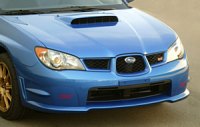 For the
flagship WRX STI, the Japanese version
again relies on the 2.0-litre engine, but higher turbo boost pressure
gives the engine a much stronger mid-range punch (i.e., from 3000 to
5000 rpm especially), while maximum torque is increased significantly
to 311 lbft from 275 lbft. Although maximum power is
again rated at 280 hp, and the weight has been increased by 30 kg,
the new STI should be quicker than ever.
For the
flagship WRX STI, the Japanese version
again relies on the 2.0-litre engine, but higher turbo boost pressure
gives the engine a much stronger mid-range punch (i.e., from 3000 to
5000 rpm especially), while maximum torque is increased significantly
to 311 lbft from 275 lbft. Although maximum power is
again rated at 280 hp, and the weight has been increased by 30 kg,
the new STI should be quicker than ever.